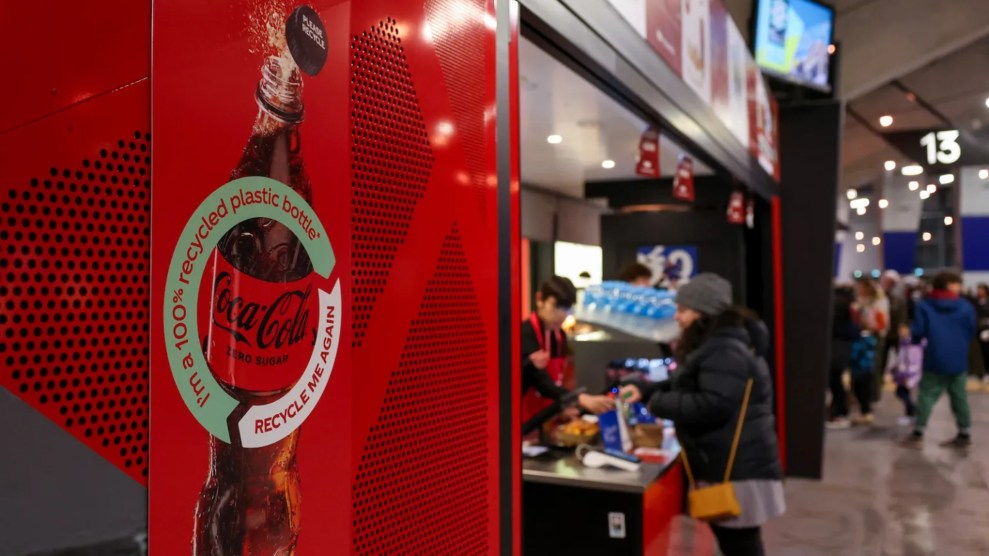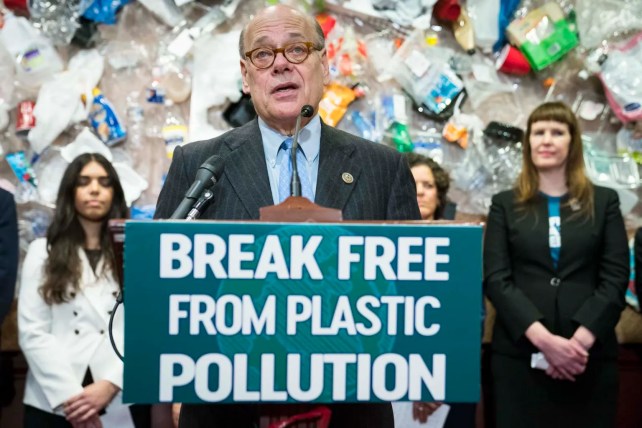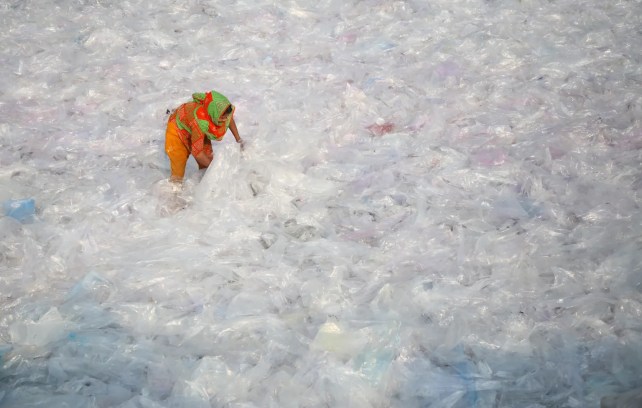
A Coca-Cola food stall sign touts recycled bottles in the stadium of the 2023 FIFA Women’s World Cup. Catherine Ivill/Getty/Grist
This story was originally published by Grist and is reproduced here as part of the Climate Desk collaboration.
At a conference in Seattle this summer, Coca-Cola set up shop in an exhibition hall to show off one of its most recent sustainability initiatives. A six-foot-tall interactive jukebox invited passersby to listen to “recycled records”—seven audio tracks that, according to Coca-Cola, represent the world’s first album made with recordings of the plastic recycling process.
The project, produced for Coca-Cola by the DJs Mark Ronson and Madlib, was meant to celebrate Coke’s decision to move from green to clear plastic bottles for three of its brands: Sprite, Fresca, and Seagram’s. Because clear plastic bottles are easier to recycle than green ones, Coca-Cola said they would advance a “closed-loop bottle-to-bottle economy” that uses materials more efficiently and creates less waste.
“Green plastic gets stuck in single-use ruts,” the company proclaims. “Clear plastic unlocks loops as sweet as donuts.”
It was just one of many creative displays at Circularity 23, an annual conference whose objective is to accelerate the “circular economy,” a term that generally refers to market systems that minimize raw resource extraction and waste. For two and a half days, 1,400 attendees—mostly from the world of corporate sustainability—wandered the halls of the Hyatt Regency hotel in Seattle, where companies like Coca-Cola were promoting their own ostensibly circular business practices. Many of these involved plastic: “reclaiming” it from rivers to create disposable mailing envelopes, melting it into its chemical building blocks so it can (theoretically) be used again, advertising its recyclability with QR codes on labels.
Circular messaging was everywhere—understandably, given the name of the conference. But what was harder to find was a succinct definition of the word: What exactly is circularity, and what makes a product or practice circular?
“I came away from the conference feeling like circularity has become synonymous with recycling, like we’ve lost the true definition,” said Sarah King, the head of Greenpeace Canada’s oceans and plastics campaign and one of a few environmental advocates who attended the event.
Her concerns reflect a broader uneasiness within the environmental community about the way corporations have rallied around circularity, aggressively embracing it in their communications but not necessarily living up to its standards in practice. Coca-Cola’s clear plastic bottles, for instance, are a form of disposable plastic—made out of oil and gas, designed for just a few minutes of use, unlikely to be recycled, and fundamentally toxic to people and the environment. It’s also worth noting that an environmental group’s audit has found Coca-Cola to be the world’s biggest contributor to plastic litter every year for the past five years. (Coca-Cola did not respond to Grist’s request for comment.)

U.S. Representative Steve Cohen speaks during a news conference promoting the Break Free From Plastic Pollution Act of 2020 in the U.S. Capitol on February 11, 2020, in Washington, D.C.
Sarah Silbiger /Getty/Grist
Some groups like Just Zero, a nonprofit that advocates for waste reduction, have dropped the term “circular economy” altogether. “The phrase is now being used to serve the interests of the huge corporations that are damaging our climate and spewing toxics into our communities,” said Kevin Budris, Just Zero’s advocacy director.
“At this point,” he added, “any time I hear the phrase ‘circular economy’ I assume that it’s greenwashing.”
The idea of a circular economy has its roots in the environmental scholarship of the 1960s and ’70s. Writings like “The Economics of the Coming Spaceship Earth,” published in 1966 by the American economist Kenneth Boulding, warned that ever-growing demand for resources could not be sustained on a finite planet. They advocated for a closed-loop system in which all resources are conserved.
These concepts resonated in a nascent environmental movement that sought to restore humans’ relationship with nature. In addition to the general environmental calamities of the 1960s through ’80s — oil spills in California, a polluted river that repeatedly caught on fire in Cleveland — the 1973 oil embargo by Middle Eastern states highlighted Western countries’ crippling dependence on nonrenewable resources. Though it’s unclear who first used the term “circular economy” — some say it was the British economists David Pearce and R. Kerry Turner in the ’80s — environmentalists were thinking critically about resource conservation and the limits to growth. (Incidentally, that was the title of a popular book published in 1972 by MIT researchers, which discussed the need to live within planetary boundaries by reaching an “equilibrium society.”)
Over the next several decades, however, the notion of a circular economy evolved into something more market-oriented. It came to prominence alongside increasingly popular ideas about “green growth” and “sustainable development,” which accepted the premise that resources must be used efficiently, but stopped short of renouncing growth. The circular economy was seen as a kind of compromise: Conserve resources, but don’t sacrifice profit.
This has made the concept extremely popular, both in the corporate world and on the international stage. The Ellen MacArthur Foundation, or EMF — a nonprofit formed in 2010 to promote the circular economy — published a report in 2015 saying that a circular economy could “decouple global economic development from finite resource consumption.” That same year, the European Commission launched its first-ever “circular economy action plan,” which laid out dozens of actions that the European Union could take to promote “sustainable consumption and production patterns.” More recently, the World Economic Forum, the World Bank, the United Nations, the Biden administration, the Chinese government, and dozens — if not hundreds — of smaller state, regional, and city-level governments have also claimed to back some version of a circular economy.
However, precise definitions of the circular economy have been hard to nail down. EMF’s 2015 report said it could be “characterized, more than defined,” while broadly advocating for resource efficiency — whether by extending products’ lifetimes through maintenance and repair or by reusing materials through refurbishment. It described a hierarchy of ways to keep materials in circulation “at their highest utility and value,” with recycling as a last resort when other options had been exhausted.
“The circular economy is a new paradigm for our whole economic system, which makes it really hard to define in one sentence or paragraph,” said Sander Defruyt, who leads an EMF initiative on plastics.
Other explanations of circularity are similarly imprecise, with a tendency to say what a circular economy does or involves rather than what it is. At Circularity 23, for example, instead of defining the circular economy, most speakers gave examples that seemed to vaguely embody its ideals, like buying secondhand clothes or growing new green onions from the roots of those you buy at the store. In a keynote address, Seattle Mayor Bruce Harrell used it to talk about his parents’ frugal shopping habits. (“We wasted nothing in the Harrell house,” he told the crowd, because his father was always “tight with the money.”) In another speech, Washington state Governor Jay Inslee broadened things even further by insisting that the circular economy should apply not only to physical materials, but also to the “joules and ergs of energy” captured by renewables.
“Everyone is talking about the circular economy, but nobody seems to know what it means,” said Vito Bounsante, technical and policy adviser for the nonprofit International Pollutants Elimination Network. In Europe, where the EU has made billions of euros available for governments, businesses, organizations, and academics to advance its circular economy action plan, he described a cynical, opportunistic scramble to use the term for attention and cash. “Just put the words ‘circular economy’ in your funding proposal, and you’ll get the money,” he said.
In theory, the circular economy captures all three R’s of the simple waste-management hierarchy: reduce, reuse, recycle. But corporate visions of the concept tend to focus on the third R, and mostly for plastics. Indeed, there’s a feeling among environmental groups that the very term “circular economy” has become a kind of code for “more plastics recycling.”
This was apparent at Circularity 23, where speakers spent panel after panel wringing their hands over “hard-to-recycle” plastics: things like bags, wrappers, and films, which are typically not accepted by the facilities that sort and process materials for recycling. Environmental groups argue there’s a simple solution to this glut of stuff: “Stop using it,” according to Judith Enck, president of the advocacy group Beyond Plastics and a former regional administrator for the Environmental Protection Agency. Advocates say manufacturers should rethink product delivery systems so they don’t rely on packaging at all, or can work with an alternative that isn’t made from plastic. But those solutions were far from many conference-goers’ minds. Instead, they justified plastic packaging on social justice grounds (“It helps make products more accessible to developing economies,” as one chemical company executive put it) and heralded the promise of chemical recycling, a controversial technology that melts plastic into polymers that can theoretically be turned into new products.
“We are pushing chemical recycling because we see that there are materials that can’t be recycled without it,” one panelist said, citing her company’s “salty snacks” packaging as an example.
Defenders argue that chemical recycling could make plastics as circular as glass and aluminum, which are considered to be “infinitely recyclable.” (Unlike plastic, they can be recycled again and again into the same products without degrading.) Even the United Nations Environment Programme has endorsed chemical recycling, describing it in a report published this May as a key solution on the path toward “circularity in plastics.”
“We are pushing chemical recycling because we see that there are materials that can’t be recycled without it,” one panelist said, citing her company’s “salty snacks” packaging as an example.
Defenders argue that chemical recycling could make plastics as circular as glass and aluminum, which are considered to be “infinitely recyclable.” (Unlike plastic, they can be recycled again and again into the same products without degrading.) Even the United Nations Environment Programme has endorsed chemical recycling, describing it in a report published this May as a key solution on the path toward “circularity in plastics.”
However, experts from outside the petrochemical industry say it doesn’t work. Independent investigations have repeatedly found that most chemical recycling projects over the past several decades have failed or never got off the ground due to technical and economic hurdles. Those in operation today mostly turn plastics into fuel to be burned for energy or industrial uses, a process that is not circular under any traditional definition of the word.
Not even mechanical recycling — the more conventional alternative to chemical recycling — seems capable of creating the “plastic circular economy” that many companies advertise. In the U.S., the plastics recycling rate is just 5 percent, and experts say it’s unlikely to improve: There’s simply too much plastic, in too many different varieties — most of which are too expensive or technologically difficult to turn back into new products. Meanwhile, plastics that do get recycled usually can’t be turned back into the same items more than a couple of times; soon, they have to be “downcycled” into something like a carpet or decking. Eventually, the plastic life cycle ends at a landfill or an incinerator, meaning more virgin plastic — made from fossil fuels — is required to make new products.

A woman in Bangladesh sifts through waste to be used for making plastic goods after recycling.
Sony Ramany/Getty/Grist
What’s more, recycled plastics may be contaminated with any number of 13,000 chemical additives, more than 70 percent of which are either known to have hazardous properties or have never been tested for toxicity. Plastics manufacturing, use, and disposal already exposes people to these chemicals — especially poor people and people of color — but mechanical recycling can keep them circulating through the economy for even longer. It can also shed thousands of tons of microplastics, tiny shards of plastic that poison the food chain and release greenhouse gases.
“There’s just no way to do plastics in a truly circular way,” said Budris, with Just Zero. Others have called the plastics circular economy “an oxymoron at its core.”
Instead of trying to “wedge” plastics into the circular economy, Budris said there’s an urgent need to reverse the plastic and petrochemical industries’ expansion. These industries are planning to triple plastic production by 2060 — in part to offset declining demand for fossil fuels used for electricity, heat, and transportation. According to the International Energy Agency, plastics are expected to drive almost half of oil demand by the middle of the century.
This issue has played prominently at negotiations for a global plastics treaty, where environmental groups have urged U.N. member states to “turn off the tap” and dramatically scale down plastic production. At the country level, they tend to support bills like the U.S.’s Break Free From Plastic Pollution Act of 2021, which never advanced out of committee but would have put a pause on new or expanded petrochemical facilities and banned several types of disposable plastic. Other countries’ efforts, like the groundbreaking anti-waste and circular economy law that France passed in 2020, limit single-use plastic alongside complementary initiatives to reduce food waste and increase the repairability of phones, computers, and other electronics.
The need to reduce plastics wasn’t completely lost at Circularity 23, either. At one panel, small business owners talked about their efforts to set up plastic-free reuse programs—one Vancouver, Canada-based company, for example, allows restaurants to serve takeout meals in stainless steel containers, which can later be returned at drop-off locations around the city. At another, Washington state representative Liz Berry spoke about her efforts to advance the WRAP Act, a far-reaching bill that would create a bottle deposit program, set mandatory quotas for reusable packaging, and hold companies financially responsible for dealing with the plastic they produce, among other things.
The most powerful rebuke of the plastics circular economy, however, came during a keynote Q&A on the second day of the conference, when Joy and Jo Banner—sisters who lead The Descendants Project, a nonprofit based in a swath of Louisiana studded with so many petrochemical facilities that it’s been dubbed “Cancer Alley”—were asked how the world should address the plastic pollution crisis. Jo responded directly to the audience by describing how her community evacuates during a hurricane: People abruptly stop what they’re doing, pile into their cars, and all drive in the same direction — away from the danger.
“That’s exactly what we need for plastics,” she said, “contraflow. We all need to move away from it, we need to stop making excuses for it, we need to stop trying to make the economy off of it. Stop giving fossil fuels a lifeline.”
The audience applauded and whooped at her remarks—in fact, the Banner sisters got a standing ovation. Then, Circularity 23 attendees went to the next event, a collection of roundtable lunch discussions hosted by Dow, Eastman, Arkema, and other chemical companies and organizations that claim to be “enabling a circular economy” through plastics recycling.
Jon Smieja, the vice president of circularity for GreenBiz, the media and events organization that hosted Circularity 23, is not unaware of the controversy surrounding the circular economy. While he believes there is no one correct way to define circularity, he said he sees plenty of selectivity among corporations when it comes to describing their circular business practices.
Many companies choose the part of circularity that “aligns most with what they feel like they can do,” he said. Some promote a circular economy even as they participate in lobbying groups that advocate against circular policies like those contained in the WRAP Act.
Defruyt, with EMF, agreed. EMF maintains there can be a place for plastics in a circular economy—the organization even has a “new plastics economy” initiative for corporations and governments to sign onto, pledging to decrease virgin plastic use, incorporate more recycled content into their plastic packaging, and make all of their plastic recyclable, compostable, or reusable. But Defruyt said companies tend to ignore important principles like eliminating unnecessary materials use and allowing nature to regenerate.
Companies ask, “I want to put something plastic on the market, how do I make it circular?” Defruyt said, instead of choosing materials and business models that are best suited to the circular economy.
In some cases, businesses adopt one or more principles of circularity without actually being circular. One company promoting itself at the conference, for example, said it takes “ocean-bound plastics” out of rivers in Southeast Asia and turns them into new mailing sleeves—a business model that might eke one more use out of discarded waste, but is predicated on, and potentially contributes to, a continuous supply of plastic litter. (A spokesperson from the company told Grist the mailers are “by no means a perfectly circular product,” but noted that they would remove waste from the environment in places where there is insufficient waste-management infrastructure.)
Another company at the conference, r.Cup, provides transparent reusable cups for concerts, football games, and other large events. Though they’re a clear improvement over disposable cups, r.Cup’s reusable alternatives are made of polypropylene, a kind of rigid plastic that can only be used so many times before it reaches the end of its life. In general, polypropylene products are only turned into new items through downcycling, though they’re more likely to be sent to landfills or incinerated. R.Cup’s founder told Grist his company’s cups are never sent to landfills and are only “upcycled” into opaque plastic cups, guitar picks, Frisbees, or other items.
Smieja called these “stop-the-bleeding stopgap” solutions that can at least reduce plastics’ impacts while, in the case of the plastic cups, proving the viability of reuse.
More broadly, a spokesperson for GreenBiz defended plastics and plastics companies’ role— both in the circular economy and at Circularity 23. “For better or for worse, plastics have a role in our current society,” the company said. “Some companies are, paradoxically, both part of the problem and key to implementing solutions at scale.”
Still, Smieja and others agreed that they might call for more specific language than just “circular.”
“Maybe we don’t have to use the word ‘circular’ with the consumer,” Suzanne Shelton, CEO of a marketing communications agency called the Shelton Group and a speaker at Circularity 23, told Grist. Rather than claiming to be circular, she said, it’s more helpful when brands describe how their products support a circular economy. If they’re compostable, brands can just say that, she said. If their products are recyclable, then advertise that—but clarify how many times they can be recycled.
That’s similar to the approach of organizations like Just Zero and Beyond Plastics, which have abandoned circular terminology despite its deep entrenchment in business and policy spheres. Erica Cirino, communications manager for the nonprofit Plastic Pollution Coalition, said there’s a risk of any term being co-opted “in the blink of an eye,” but she and others prefer to use words like “reusable,” “refillable,” and “zero-waste,” which more precisely convey the concepts of material conservation and resource efficiency. King, with Greenpeace Canada, said she also tries to emphasize slowness, with reduced production and consumption throughout the economy.
Not all corporations, governments, and intergovernmental organizations, however, are likely to make those distinctions voluntarily. If the circular economy is going to remain in the corporate and policymaking vernacular—as it likely will—then environmental groups say it should be qualified with terms like “toxics-free” or “reuse-based.” Ideally, they’d like regulators to step in with clearer guardrails against greenwashing.
“I think the Federal Trade Commission should take it on,” said Enck, from Beyond Plastics. The FTC, which protects U.S. consumers from deceptive or unfair business practices, is already working on revisions to its Green Guides, a set of guidelines around companies’ sustainability advertising. The most anticipated revision is expected to offer a firmer definition of the term “recyclable,” but Enck said there’s no reason it couldn’t also define circularity, potentially with different criteria for different industries. (The Green Guides updates were expected by the end of last year but have been delayed. It’s unclear when they will be released.)
“The first pillar needs to be conservation of resources and efficient use of resources,” Enck said, calling for guidelines that prioritize the three R’s of the zero-waste movement: “reduce, reuse, refill.”














